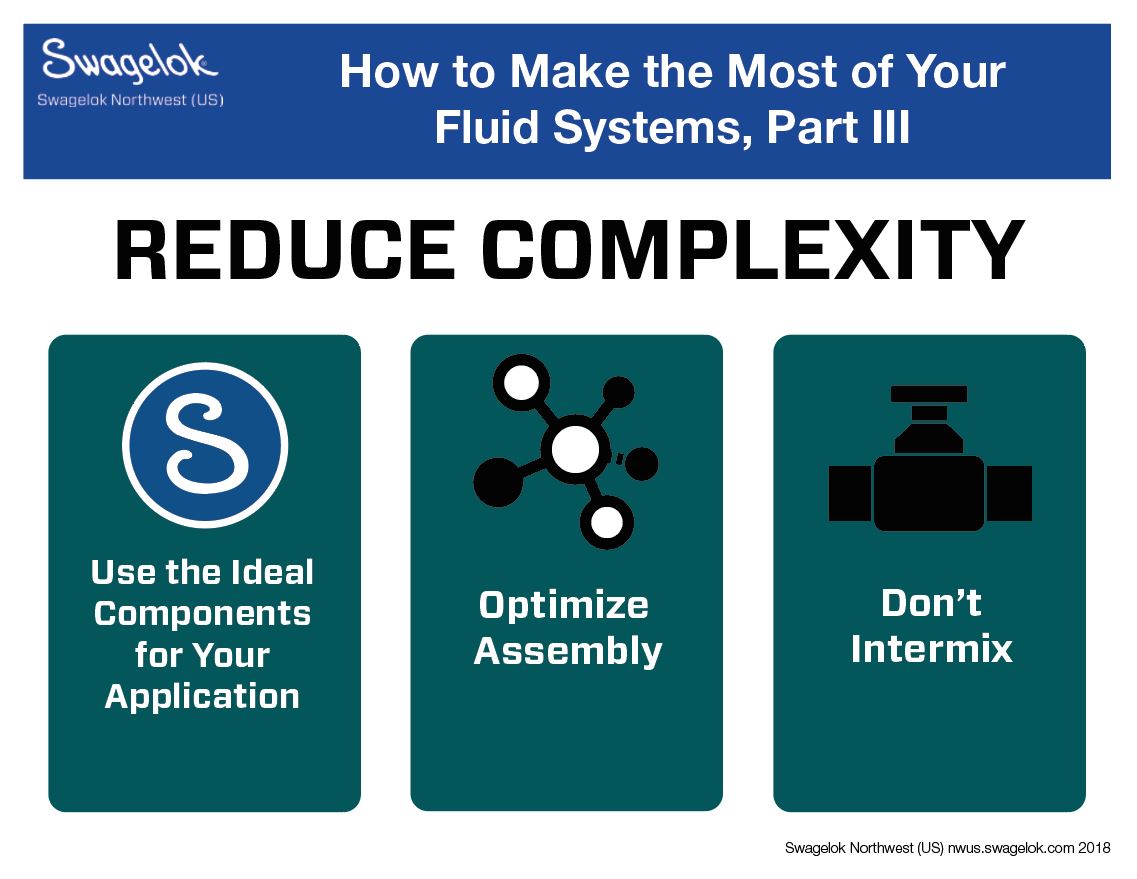How to Make the Most of Your Fluid Systems, Part III
Part three of a three-part series on how to maximize the performance of the fluid systems in your facility
Plant managers like you are responsible for safety, uptime, and a steady stream of revenue for your facility. Industrial fluid systems transport high-pressure and high-temperature fluids and gases, making them central to your concerns. The most effective fluid systems are simple. The engineers and technicians who build and maintain these systems can reduce the complexity of your system, ensuring optimal performance, with these three strategies.
- Use the Ideal Components for Your Application
- Don’t Intermix
- Optimize Assembly
1. Use the Ideal Components for Your Application
Selecting the best components for your application requires you to completely understand process conditions. This checklist can help you make sure that you are taking every detail of your fluid system components into consideration.
- Review and follow manufacturer instructions
- Consider the lifespan of each component
- Consider material compatibility
- Make sure that tubing materials have the right hardness to stay connected
- Know the difference between similar-sounding parts
- Be precise in your component selection. For example, a safety valve is not the same as a relief valve. A safety valve opens fully at a set pressure while a relief valve opens gradually as pressure increases. This minor difference can have a major impact on safety and operations in your plant.
- Be sure that your system design allows for a proper range of motion for moving components
- Check tubes for ovality, defects, or scratches before installing, these can compromise the seal
- Check the wall thickness against fitting manufacturer limitations
- Make sure you tighten fittings carefully to avoid leaks or blowouts and use a gap inspection gauge to confirm appropriate fitting pull-up
- Make sure that tubing is resting firmly on the shoulder of the tube fitting body before you tighten it
- Add proper supports to make sure that tubes and fittings don’t fatigue in high-pressure usage
- Hose may absorb vibration better than tubing, so think about switching to hose in situations with intense vibration
- Distribute hose movement over an appropriate length to prevent any bends smaller than the hose’s minimum bend radius
- Buy components through trusted partners or authorized channels. Counterfeit or substandard components can damage your system operations and affect plant safety.
2. Don’t Intermix
Interchanging or intermixing components from different manufacturers can create unpredictable performance, safety issues, and higher costs. A simple half-inch fitting can create a dangerous blow-out if it doesn’t have the correct tolerance. Components from different suppliers may look alike but they aren't always held to the same manufacturing standards. Replacements may not perform properly with other manufacturers’ components.
A leak-tight seal should stand up to high pressure, temperature changes, vibration, and more. A quality seal depends on exacting quality control and rigorous design. Choose a consistent, reliable manufacturer for every component in your fluid system. This will ensure quality throughout your fluid system operations.
It is also important to keep replacement inventory on hand for your most critical system components. Also, be careful when storing hose, and remember these tips:
- Hang hoses instead of stacking them. This will ensure that they don’t bend more than the manufacturer published bend radius.
- Protect hoses from ultraviolet (UV) light
- Cap both ends of stored hose to prevent interior contamination
3. Optimize Assembly
Mistakes happen even in the strongest teams. You can reduce human error by following best practices for fluid system design.
- Make time to consistently label components
- Mount detailed tags on equipment and hoses to show what happens within each system
- Color code handles, pipes, and tubes in your plant, so your team can easily identify what types of fluids or gases are flowing through them
- Add a lockout on critical process valves to prevent accidental actuation
Reduce fluid system complexity wherever possible
Simple systems make maintenance more efficient and make it easier for technicians to troubleshoot problems.
Request Custom Solutions
Your assembly may be simple, with just a few components. It may be a complete panel or enclosure. Either way, you want a trusted supplier that can build consistent high-quality assemblies. You want to know that the assembly will simplify your system, streamline internal processes, and provide you peace of mind.
Swagelok Northwest (US) Assembly Services can build a system from your concept, create a new system from your drawings, or convert existing piping and instrumentation diagrams. We offer engineering and design support. We also have simple processes for configuration and ordering. Assembly Services reduces waste and labor costs. This service also offers shorter production times than building systems in-house.
We build your assembly with in-house premium components. It's assembled by factory-trained installers, and we put your assembly through rigorous testing to ensure quality. We stand by our custom solutions, and all assemblies have the backing of Swagelok's Limited Lifetime Warranty. Reach out to begin the process today.
Make the most of your fluid systems, check out Parts I and II of this series.

